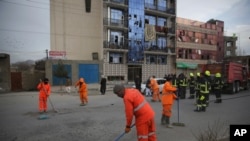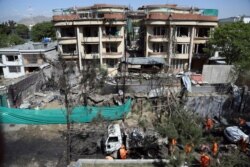Nineteen Afghan civilians were killed in multiple roadside mine blasts in Kabul and Kandahar Sunday.
Two of the blasts occurred in Arghistan district of Kandahar province in southern Afghanistan.
In the first incident, a Toyota pickup carrying civilians hit a roadside mine near Shana Nari village killing nine and wounding two more Sunday afternoon, according to a spokesman for Kandahar provincial police, Jamal Barakzai.
The second incident occurred near Tajaw village when a van hit a mine, killing eight Sunday night.
Meanwhile in Kabul, two civilians including a woman were killed while security personnel were trying to depose of a roadside landmine.
The civilian casualties happened on a day when Afghan President Ashraf Ghani announced he would release the remaining 400 Taliban prisoners—removing the last remaining hurdle to the start of direct negotiations with the militant group.
Reducing civilian casualties and working toward a ceasefire is expected to be the highest priority of the Afghan team—an amalgamation of government representatives, other political factions, and civil society activists—when it meets the Taliban in Doha in the coming days. The two sides are supposed to negotiate a political settlement that ends four decades of conflict in Afghanistan.
“In the next few days, we expect the completion of prisoner releases, then travel of the Islamic Republic team to Doha, and from there the immediate start of intra-Afghan negotiations,” Tweeted Zalmay Khalilzad, the United States Special Representative for Afghanistan Reconciliation, early Monday morning.
Khalilzad, who headed the U.S. negotiations with the Taliban, had been proposing to start the intra-Afghan negotiations urgently. However, parts of the U.S. deal with the Taliban—particularly the promise to release up to 5000 Taliban prisoners as a pre-requisite to start direct negotiations with the Afghan government—irked Ghani, who felt this took leverage away from him.
Ghani’s government had since been dragging its feet on the prisoner release issue, trying to link it to the announcement of a ceasefire by the Taliban. Not only was this demand repeatedly rejected by the group, according to the Ghani administration, it ratcheted up its attacks against the Afghan security forces.
In a video address to a regional conference last month, Ghani said Taliban had killed or wounded more than 10,000 members of Afghan security forces in the months since the U.S.-Taliban deal in February.
The mood of the general public in Afghanistan seemed to be overwhelmingly upbeat about the start of talks. Although, there was some criticism in social media posts, particularly from human rights and women’s rights groups, over releasing the 400 hardcore Taliban.
There was some concern that the team finalized to represent the Afghan government and other Afghan factions was not representative.
“The Kabul team is not qualified I feel. They are children of political big wigs. It seems like the same old sharing of the pie. Public opinion is not wholly reflected,” said Mushtaq Rahim, a Kabul based independent political analyst. He added however that at the time all everyone wanted was for intra-Afghan negotiations to start.






